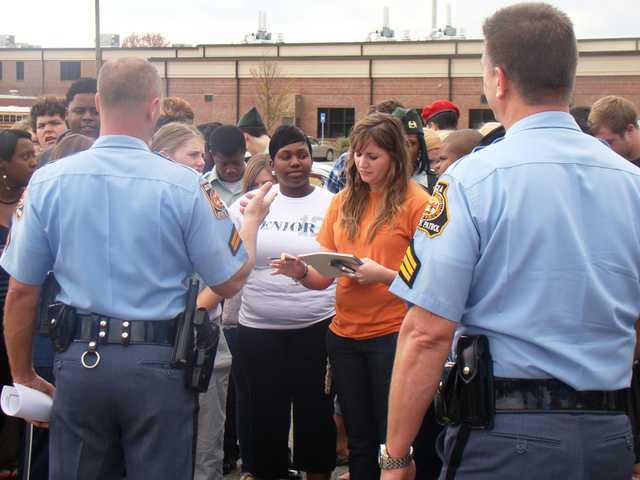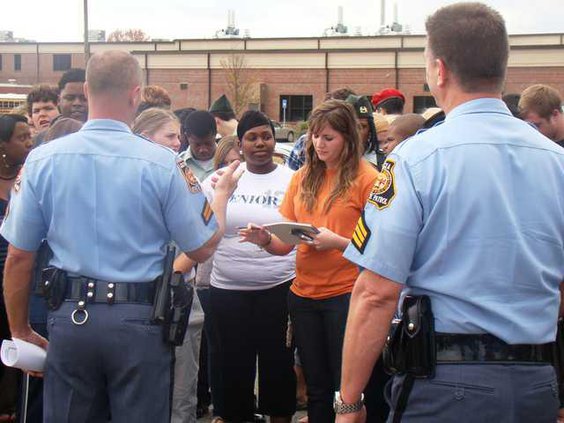Seven members of a Georgia State Patrol Specialized Collision Reconstruction Team visited Statesboro High School math teacher Paige Sutcliff’s Math IV classes Wednesday morning to show students how common trigonometry theories are used in accident investigations.
“My goal was to teach students how they can use math skills they’ve learned in class,” said Sutcliff.
The team showed students how they gather information on known distances, drag factor and speeds and then utilize mathematical formulas to create a forensic map of an accident scene.
“The Pythagorean Theorem is the groundwork of what we do,” said GSP Cpl. Craig Smith.
Armed with sine, cosine and tangent, the team analyzes falls, flips, roll overs, vaults, speeds or skid marks made by vehicles to determine the truth.
“When I was in school, algebra was an elective, and you can guess what I elected to do,” Smith laughed. “I didn’t think I would ever use it. I wasn’t in law enforcement long though before I realized I should have taken more math.”
To give students a problem of their own to solve, the team staged a two-car accident scene and created a set of fresh skid marks using a GSP vehicle. The team showed students how to obtain various measurements, and then students used them to make calculations.
These aren’t their only clues. In a driving safety presentation prior to the demonstration, the team explained the sophisticated safety deployment systems in today’s modern vehicles. Similar to an aircraft’s black box, these devices record data 20 seconds before a crash and control seat belt and airbag deployment. SCR teams can download this information.
“It’s like a video camera,” said Smith. “They’ll tell on you if you’re doing something wrong.”
The team spoke to students about not texting while driving, wearing seat belts and obeying speed limits.
“An air bag deploys in milliseconds, and if you’re not wearing a seat belt, you’re moving at least 60 mph,” said Smith. “When the two meet, it will cause serious neck and head injuries or death.”
“When speed is involved, the end results will always be bad,” added GSP Senior Trooper Roger Cason. “When someone hits you at 55 mph, it’s like a bullet coming out of a gun toward you. The faster the speed, the bigger the mess.”
Created in 1998, the GSP’s SCR Unit consists of five teams whose thorough, 100-plus page reports prove math matters in getting to the truth.
“The math formulas we use have been proven to hold up in court,” said Smith.
“Now, unlike 12 years ago, we can better determine fault in fatality accidents,” said Cason. “Before people were walking away because there just wasn’t enough evidence from a regular, two-page accident report to gain a conviction.”
This team, headed by GSP Sgt. Ben Garrett, covers a 37-county territory and is based out of Reidsville.
“Our initial training is a five-week basic course and then continuous, specialized training after that,” said Cason.
The team shared with students their reference booklet of common mathematical formulas. Other team members on site were Senior Trooper Scott Fisher, Sergeant Ben Garrett, MCO Mike Kitchens and Secretary Amy Terrell, who helps coordinate the team’s deployments.
On-the-job trigonometry
Students get a lesson from Georgia State Patrol


Sign up for the Herald's free e-newsletter